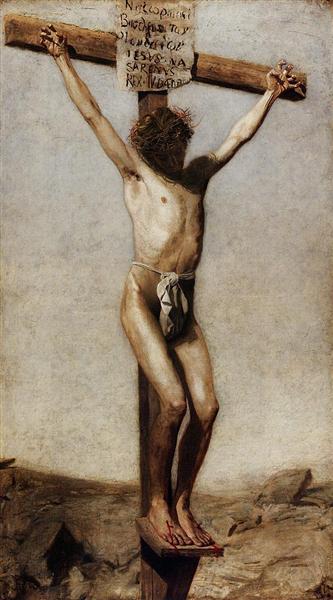Beschrijving
Thomas Eakins' painting "The Crucifixion," painted in 1880, is an iconic work that encapsulates the artist's technical mastery and deep understanding of the human body. Known for his realistic approach and ability to capture human anatomy, Eakins offers an intense and moving interpretation of a classic religious subject in this work. Although the painting depicts one of the most significant events in the Christian tradition, its treatment lacks the pomp that often accompanies such depictions; instead, Eakins opts for a humane, almost scientific approach to the subject.
The composition of the work is cleverly structured around the central figure of Christ, who is crucified at the top of the canvas. The setting is dark and shadowy, contrasted by a light that dramatically illuminates his figure. This use of chiaroscuro not only highlights the shape of Christ’s body, exposing the musculature in a visual narrative that seems almost tangential, but also evokes a sense of spiritual depth. Eakins paints Christ with meticulously studied anatomy, reflecting his commitment to realism and physiological accuracy. This attention to detail is characteristic of his style, in which he seeks to portray not only the external appearance, but also the emotional experience of the subject.
In the background, other figures can be discerned who, while not the main focus of the work, contribute to the narrative. These figures, less clearly depicted, seem to observe the scene with an air of sorrow and pain, suggesting the tragedy of the moment. The composition itself is generally horizontal, with the cross visually intersecting the space, reinforcing the idea of elevation and sacrifice. The mostly sombre colouring reverberates with earthy tones that reinforce the seriousness of the subject, though more vivid colours are also glimpsed, especially in the clothing of the figures surrounding Christ, adding an element of emotional contrast.
Eakins' style in "The Crucifixion" is a clear example of his commitment to realism, which is often characterized by his rejection of the idealized conventions of academic art of his day. Through his work, Eakins does not simply seek to document a religious event, but instead focuses on humanity, suffering, and the pain of sacrifice. In this sense, his work resembles other masters of realism such as Gustave Courbet, who also challenged the established norms of representation in his time, although Eakins focuses more on the human figure and anatomy.
Eakins' history and development as an artist are intertwined with his time at the Pennsylvania Academy of the Fine Arts, where he was a strong proponent of the direct study of the figure and anatomy. This artistically rigorous education is evident in "The Crucifixion," where every crease and shadow seems to emerge from meticulous, prolonged study. However, the work also invites us to reflect on the role of art in depicting spirituality and religion, at a time when realism was on the rise.
In short, Thomas Eakins's "The Crucifixion" is a work that transcends its simple representation of a religious moment to become a profound analysis of human sacrifice. Through his unique technique and perspective, Eakins invites the viewer to a contemplative experience about pain, faith and the human condition, consolidating his position as a classic of 19th-century American art.
KUADROS ©, a famous painting on your wall.
Hand-made oil painting reproductions, with the quality of professional artists and the distinctive seal of KUADROS ©.
Painting reproduction service with satisfaction guarantee. If you are not completely satisfied with the replica of your painting, we will refund 100% of your money.

